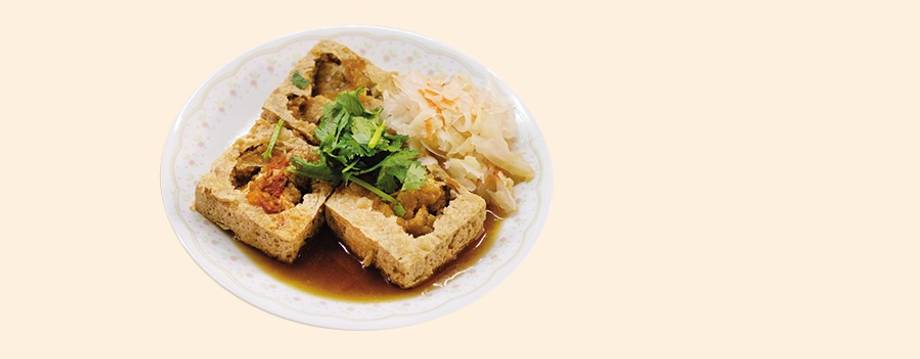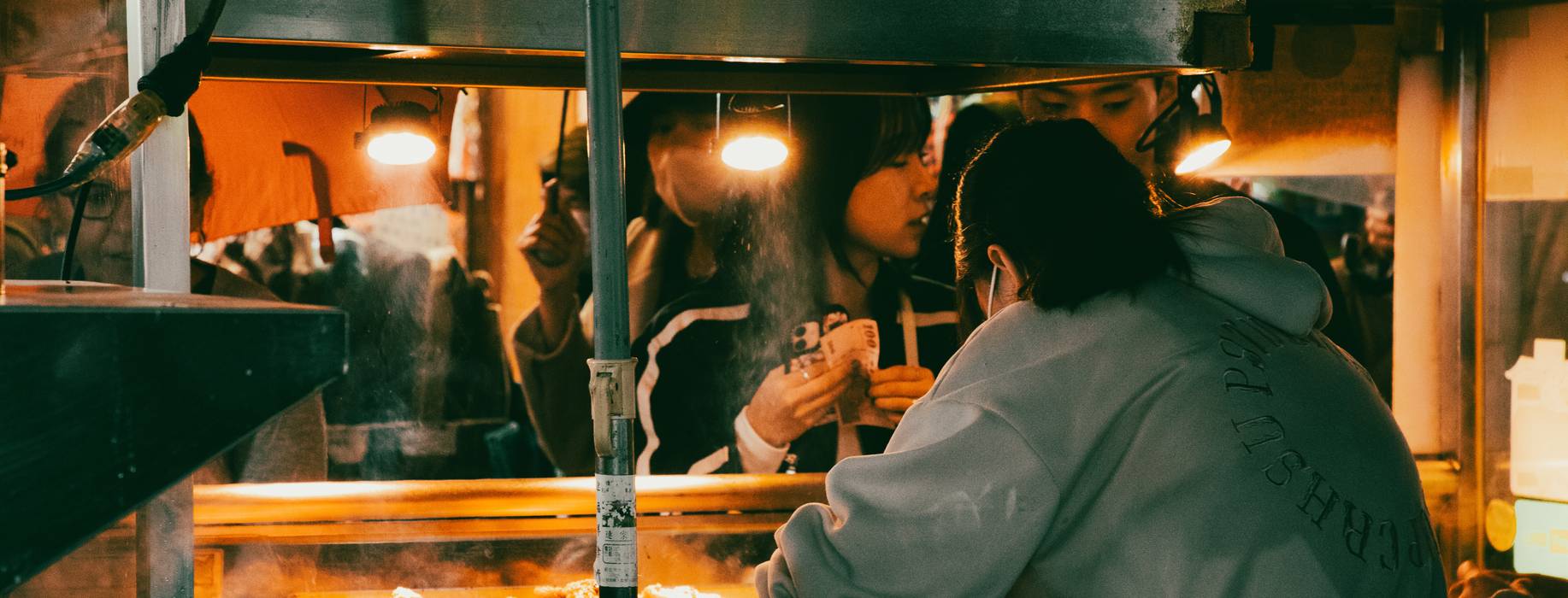Taipei by nightmarket
Internationally known and loved for its incredible night market culture, Taiwan takes street food to a whole new level
Robyn Gilmour
Photos:
Doug Wilson Garry
Saturday 31 May 2025

This article is from
Taiwan
issue 118
Share this article
There are several night markets around Taipei, each renowned for different reasons. Nanjichang is small but centrally based, with a wide variety of foodie options. Raohe Street is bigger and can be more touristy, but provides a quintessential night market experience with its tightly packed stalls, narrow street, and traditional decoration. Shilin is perhaps the most famous, but is quite spread out so might not be the best destination if you’re starving, and want to survey your options quickly before settling on a couple of dishes. These markets operate between sunset and sunrise, and while some are housed in custom-built arcades, most transform streets that bustle with traffic and pedestrians during the day.
Groups of peddlers selling wares after dark aren’t unique to Taiwan, but night market culture here really took hold after the second world war, when Taiwan’s booming, industrial economy required migrant workers to be fed cheaply. The markets became places to eat, meet with friends, and buy basic goods at a low cost, transforming these transient spaces into teaming social hubs.
Today, the stalls with the longest queues are often run by families that trace their lineage to Fuijan, Meizhou, Jiangsu, Zhejiang, Huan and Sichuan. In Taiwan, culinary influences from these regions marry with local tastes and traditions. Sautéing, braising, steaming and deep frying are the most common cooking methods here, and a heavy use of soy sauce and sugar is somewhat of a Taiwanese trademark.
While bigger vendors offer a handful of tables and chairs to patrons, these markets are busy; have cash ready, be prepared to stand clear of the flow of the crowd and slurp down a bowl of soup on foot, or hunker into a comfortable squat near the curb to trade fried squid for some of your friend’s sweet potato balls. This is street food in its truest sense, so embrace it. Follow your nose, order with your eyes, but if you want to go in search of some night market must-trys, we’ve compiled a list of our five favourite dishes.

Pepper cakes | PHOTO: Taiwan Scene
Pepper cakes (hu jiao bing):
In the UK, a ‘bun’ or ‘cake’ connotes sweetness, but Roache Street Market’s pepper cakes are anything but. Here a flattened patty of light, stretchy dough is wrapped around a spoonful of minced pork that’s been seasoned with green onion and lots of pepper, then baked in a charcoal-fired tandoor-style oven. The result is much greater than the sum of its parts, and guaranteed to see you gladly burn your mouth on its steaming filling. Originating from Fuzhou in Fujian, the pepper cake has been embraced and reimagined by local vendors over generations. Now a staple of the Taiwanese night market experience, it reflects the island’s unique ability to adapt and elevate classic flavours into something distinctly local.

Stinky spicy tofu | PHOTO: Taiwan Scene
Stinky spicy tofu (chou doufu):
You’ll smell the stinky tofu stand long before you see it. The aroma is pungent — sour and savoury, musty in a way that evokes white pepper — and might even be described as ‘ripe’. That doesn’t sell it, and it's easy to see how the corresponding flavour can be polarising. That said, there are two ways to eat stinky tofu; fried or steamed (served in soup), with the former proving much more palatable to those on the fence. Stinky tofu is a popular snack in many parts of the world, with regional trends (or even family traditions) dictating how the tofu is fermented. In parts of China, a koji, or qu-based broth is often used as the starter culture, but elsewhere a home-made brine might age the tofu, sometimes for months, giving it its pungent odour. While the means of fermenting the tofu might best be considered on a case by case basis, the way it’s most commonly served in Taiwan, is fried — with pickled cabbage and garlic sauce — or barbequed. If faced with the opportunity to try this legendary local dish, I implore you to be brave; it’s both delicious and nutritious.

Egg pancake | PHOTO: La Vie En Toast
Egg pancake (dan bing):
A real crowd pleaser, this stalwart of the Nanjichang night market is everything you want in a late night bite, but is commonplace in the city’s breakfast joints too. These thin, crepe like pancakes are the perfect vessel for almost any filling: ham, cheese, corn, pork floss (dried shredded pork, flavoured with soy sauce and spices) and green onions, even Youtiao (a Chinese doughnut, see page 32). However, the real joy of dan bing is its texture. The pancake, consisting of a thin batter made of tapioca or sweet potato flour — is partially cooked on a hot grill before a beaten, seasoned egg is added on top, followed closely by your filling of choice. The whole thing is then rolled up and served with a drizzle of oyster sauce or chili oil. The result is a layered bite, comprising the pancake's crispy exterior, a chewiness just below the surface, and spongy egg. Culinary perfection.

Taiwanese fried chicken | PHOTO: Tiny Urban Kitchen
Taiwanese fried chicken (ji pai):
Forget Southern or Kentucky Fried, the Taiwanese take will punch a hole in your expectations of fried chicken. Like every night market delicacy, each vendor will have their own signature take on the style, but overwhelmingly, the butterflied chicken, crispy coating and distinctive sweet, garlic and five spice seasoning will sear every bite in your memory. Interestingly, the seasoning (for the most part) isn’t incorporated into the floury coating, but sprinkled on top just as the sizzling chicken is pulled from the frier, with the result being that any sugar in the seasoning melts ever so slightly, adding to the crunch without burning in the hot cooking oil. We order two portions between three of us (which collectively costs under £4), and take our prize into an adjacent bar where Taihu Brewing just happens to be pouring. The chicken doesn’t bring any bitterness out in the crisp, cold lager, which is just dry enough to balance the sweet and deep savouriness of the chicken. This would be my death row meal, no questions asked.

Braised pork rice | PHOTO: The Michelin Guide
Braised pork rice (lu rou fan):
While we sampled all the above dishes at either Nanjichang or Raohe Street market, we picked up this dish for lunch at a restaurant called Yi Jia Zi in New Taipei City. Due to the incredible popularity of Lu Rou Fan in Taiwan, we thought it worthy of a mention here, and should absolutely be on your list of dishes to look out for. Like Fuhang (page 32) Yi Jia Zi is highly decorated with Michelin Bibs, in spite of offering no inside seating, and just a smattering of outside tables and chairs on the street. The menu is small and the queue is long; we probably killed an hour waiting in line but it was time well spent for the fatty, salty, sweet and tender pork that awaited us. Served on a bed of short grain rice and with a generous handful of sharp, quick-pickled cucumbers, this is a lunch of champions. If you’re not quite hungry enough for a big meal, grab a gua bao; that same stick pork belly is packed into a bao bun with pickles and ground peanuts. This is another Taiwanese street food staple!
Share this article

